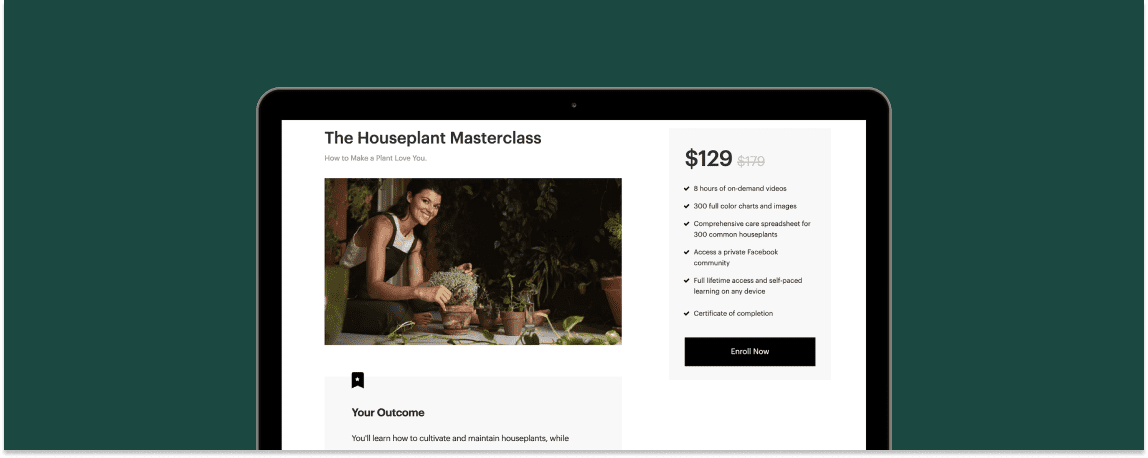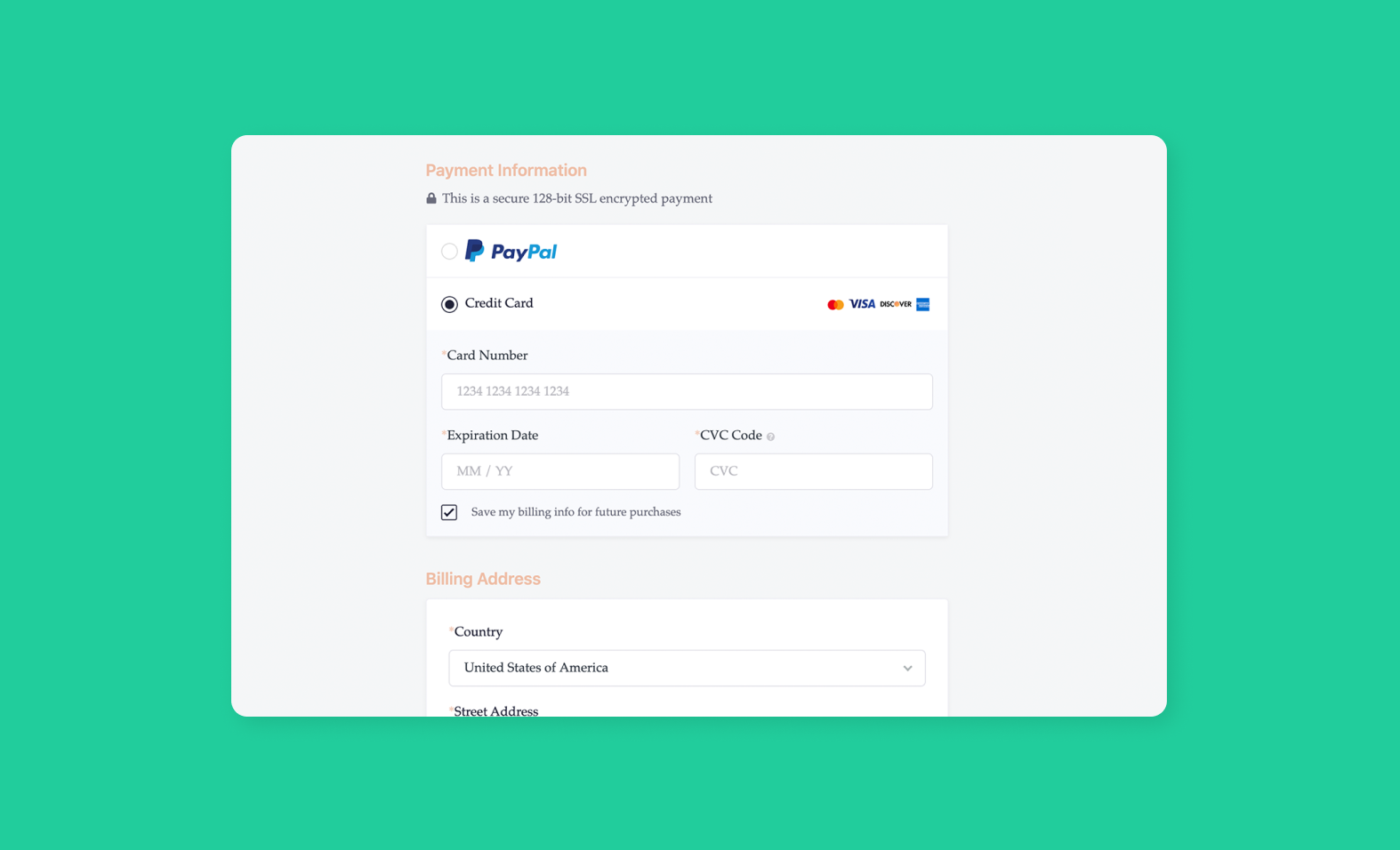Online education is more popular than ever, and teachers like you have wider audiences to market to as well. Whether you’re an experienced educator or are looking to launch your first online class, it can be tough to bring students to your online courses, especially if you don’t already have a dedicated audience.
Luckily, you don’t need to spend tons of money on online advertisements, nor do you need to hope Google’s SEO algorithms favor you over your competitors. Instead, you can take advertising into your own hands if you learn how to market online courses effectively.
Let’s take a look at 41 ways you can do just that.
How to market your online course before it’s ready
Advertising for online classes doesn’t have to begin after your course is ready and uploaded to a quality learning platform like Teachable. You can market your course before making it with a few smart strategies.
The below steps are important for ensuring your later marketing efforts succeed. Think of them as the groundwork you need to do before promoting your online course.
1. Identify your brand’s USP
First, identify the USP or unique selling proposition of your brand. Of course, “brand” in this sense can be just you as a person or your reputation as an online teacher.
Regardless, the USP is what separates you from other online educators.
It’s important to identify your USP, so you know what you bring to your students and can highlight that in all of your marketing and promotional materials. Your
USP can be things like:
- The affordability of your online courses
- Your expertise in your educational niche
- The quality of your online courses
- Something else entirely
Bottom line: make sure you know what separates you from the pack of other online educators before selling online courses. It is the number one way to ensure that students understand the intrinsic value of your educational offerings before making a purchase. It’s also a great place to showcase the transition students can expect to undergo after having gone through your course.
2. Determine your target audience
Next, you need to determine the target audience you’ll primarily sell to. For example, if you make online marketing classes about UX design, your target audience will include:
- Small business owners
- Online entrepreneurs
- UX students
- Online marketers, etc.
Your target audience is the group of people most likely to purchase your courses or attend your lessons regularly. Again, by identifying your target audience, you’ll be better equipped to market to them effectively.
For example, you can make an ad that speaks to them more directly and clearly instead of a generalized ad that doesn’t pull them in or persuade them to view your materials.
You can determine your target audience by:
- Performing market research, such as keyword research
- Using some common sense—for instance, if your courses are on a specific subject, your learners will necessarily be professionals in the same industry
- Considering your experiences as a teacher
{{audience-component="/blog-shortcodes/blog-popup"}}

3. Create a “student avatar”
The next step is to create a so-called student avatar. In a nutshell, a student avatar is a representative example of a member of your target audience or the people most likely to enter your marketing funnel. You’ll often hear this called an audience persona, too.
Say that your audience comprises small business owners who want to know how to make a clean e-commerce shop user interface. That’s perfect for your courses because you teach how to make UIs for small websites.
The student avatar might have characteristics like:
- Aged between 25 and 45
- Generally female
- Interested in clear solutions and streamlined tutorials
No matter the exact demographic characteristics or attributes of the student avatar, the point of understanding them is the same. When you create a student avatar, you can advertise to that persona more easily and effectively.
4. Research keywords for titles
Before drawing up a list of potential courses to create, you should research keywords for course titles. Course titles can and should take search engine optimization (SEO) into account, as the titles will impact who finds your courses and how you can categorize them.
Researching keywords can also be advantageous since doing so can help you develop course or topic ideas if you are having trouble.

5. Pre-sell the course
That’s right; you don’t have to sell online courses after they’re done. It might be smarter to pre-sell your courses by letting people purchase them or a tutorial/trial class within the larger course ahead of time.
Pre-selling a course is advantageous because it lets you test out course ideas. If, for example, you pre-sell two courses that you haven’t yet created and one has many more pre-sales compared to the other, you know which of the courses you should focus on. It’s also a fantastic way to gather feedback, secure testimonials, and test the waters with ideas. Learn more about how to run a pre-sale here.
6. Make a “Teacher Profile” page or section
Lastly, you can build trust and your brand authority as an educator if you create a teacher profile page on your website or course sales page. The teacher profile page should include:
- Your history as an educator
- Any relevant credentials to the subjects you teach
- What you plan to bring to potential students, etc.
You should mainly focus on credentials (strong social proof) and authority on this page. But it’s also a great place to share your brand mission statement or course goals. Be sure to link to the teacher profile page in every course description, especially for new courses in untested subjects or niches.
A teacher profile page is even more important if you are a new educator and don’t have a willing audience of trusting students quite yet. Pro tip: include some contact information, such as an email or social account. That way, your potential students can ask questions and see if the course is a fit for them.
How to market online courses once they’re ready
Naturally, most of your marketing work will occur after you create an online course (or several) and are ready to bring students to your materials. Fortunately, you can employ many effective strategies to promote your course after making it and uploading it to Teachable. Here’s how to promote online classes once they’re ready.

7. YouTube promotions
For starters, one of the best ways to advertise a course is through YouTube promotions. YouTube promotions are much more effective nowadays since people are used to viewing video content for ads, promotions, and breakdowns of online courses.
YouTube promotions can be even more effective if you leverage several subsidiary strategies:
- For example, you can partner with other YouTube creators and cross-promote your courses with each other. This may allow you to bring students from each other’s audiences without having to attract new students.
- You can join the YouTube Partner Program and create advertisements that show up on related videos.
8. YouTube Ads
Dedicated YouTube ads take some time to create, but they’ll pop up in front of your videos or the videos of related content creators. Think of these as traditional commercials seen on TV. This marketing strategy will likely be more approachable and effective as you earn money and solidify your place as a major educator in your subject.
9. Blog announcements
Blog announcements can also be highly effective. For example, you can make a blog post announcing the recent launch of one of your new courses. The benefit of announcing new courses on your blog is that you can tie them into previous classes you’ve already released or represent the classes however you like.
Similarly, you can cross-promote by partnering with other educators or brands and announce your class on their blogs and vice versa.
10. Student testimonials page for your website
You might consider creating a student testimonials page for your website or a sales page to market a class. Student testimonials are highly advantageous because they:
- Boost brand authority for you as an educator
- Show potential students that your previous students had a great time learning from your classes
- Allow students to gain some insights into your teaching style and your specific benefits
Of course, your testimonials should be legitimate and taken from real reviews. This leads to the next major tip…
11. Ask for course reviews
Don’t hesitate to ask former students for course reviews or testimonials about your teaching abilities. If you’ve just launched a new course, you can ask for reviews for prior classes those students completed.
Asking for course reviews, feedback, and testimonials is highly recommended for your personal branding. Getting the positive word out there and gathering good reviews for your testimonials page is a great way to convince new students that you are worth their time and money.

12. Make a dedicated course page for your website
You don’t have to have a website to have a course page on Teachable. Teachable can act as your business’s homepage and course directory.
However, if you have your own website, be sure to update the links and information about your course or courses. Each new course you release should have a dedicated page on your website. The dedicated course sales page should include the following:
- A breakdown of what the course includes
- Details about how long the course is and how many subclasses it includes
- What students will learn by the end
- Who the course is meant for
- Any other pertinent information
Think of the dedicated course page as a product description for prospective students. The more information you give them, the greater the likelihood a student will sign up for one of the courses since they’ll feel confident about their purchase.
13. Update the existing course page
Alternatively, you can update your existing collective course page if your site has one already. This is essentially a listing page that breaks down all the class offerings you have as a teacher. Be sure to update this each time you launch a new class or change how you price your courses.
Many of your former students will visit the existing course page rather than click on advertisements since they already trust you. Updating the existing course page will make your new class offerings more accessible to new and former students.
14. Email newsletters
Email newsletters are perhaps the best way to market online courses. Getting leads for your newsletters is easy by requiring student emails from every new student who signs up for a class.
If you already have an email list, send out course announcements when you make a new class and invite your students to watch it on your platform. Your marketing newsletters should also include special deals or discounts (more on those below) if applicable.
15. Email signature links
You can passively promote online courses by adding a link to the new class or your educational platform in your email signature. Your email signature is used for all of your professional correspondence, either between your students or other individuals and organizations.
Having the link to your new class in your email signature gets the word out there that you have a new course ready for viewing. It’s a great way to bring a few extra people to your class without having to do much.
16. Podcast announcements
Are you into podcasting? More importantly, are your students? If you answer one or both of those questions “yes,” then you should feel free to announce your new classes on any podcasts you are a part of. It’s a smart, stellar way to market and sell online courses to those interested in your courses.
Whether you host your own podcast show or are a guest on someone else’s, be sure to plug your new class at the end. Most podcast hosts are fairly relaxed about this, as they’re used to product placements or advertisements being a part of their shows.
17. Make a free trial
You can’t go wrong with allowing new students to sample your educational wares without having to pay a penny. To do that, create a free trial for every new course or class you make.
Platforms such as Teachable allow you to do this with a few button presses. But no matter what platform you use, you should make a free trial by:
- Giving students unlimited access to the course for a short timeframe, like 24 hour
- Giving students unlimited access to one part of the course, like the first two lessons, but requiring them to pay for the rest
No matter which trial strategy you employ, you can rest assured it will be quite effective at getting new students to want to get the full course offering once they see the beginning. Just be careful not to make your free trial with too much freedom and flexibility; otherwise, you might find that a few highly productive students complete your class within the free 24-hour period, for example.
{{pricing-component="/blog-shortcodes/blog-cta"}}
18. Offer a free mini course
Alternatively, you can create a free mini course. This is a great lead magnet, which will help draw new leads to your brand and other courses you offer.
For example, if you make a new course with three sub-classes contained within, you can offer the first one free on your website. This is similar to a free trial, but it doesn’t have the same time limit element and might be a little more effective.
Naturally, any free mini courses you offer should be valuable and accessible from the get-go. The point of mini-courses is to draw students to your larger class offerings. So make sure any mini classes you launch have valuable information while also serving as a taste of what else you can provide.
19. Host a webinar
As an online educator, you’re probably already comfortable getting in front of a video camera. If this is true, consider hosting a webinar for prospective students looking to learn more about your course offerings.
Your webinar can be on your chosen niche or industry, of course. Make sure it provides some interesting information about your current topics and subjects, such as how to sell an online course. The webinar can be a promotional tool if you plug in your new class at the beginning or end of the session.
Of course, you’ll need to promote the webinar regularly to ensure enough people attend. But done right, a webinar can provide lots of marketing benefits. For example, it can improve your authority in your industry if enough people attend and see that you know what you’re talking about.
20. Cross-promote with other courses
If you already have more than one class under your belt, it should be a simple affair to add a promotional line about your new class to the end-of-current course offerings. Include a link to your course, too. This way, you can advertise new classes to students already in your educational pipeline.
They might finish a current course, then notice an advertisement or offer for a new class you just released. If they appreciated the current educational offering, they might be well-prepared to make an immediate purchase and jump into your next course on the same day.

21. Bundle a new course
You can also attract people to new classes by making them more economically worthwhile, improving sales for your online course offers. For example, you can market online courses by bundling them with old courses.
Say that you just came out with a new class for a subject that relates to your best-selling course of all time. To get people to view the new class, bundle it with the best-selling course and ensure the price is lower than if someone were to buy both courses separately.
While you may not get as many sales from those who have already taken the other course, you might get many more new students who jump at the opportunity to learn from you at a lower-than-average price.
22. Discounts and sales
Speaking of low prices, you can always offer discounts and sales for your new classes, especially in the earliest months after launch. Discounts and sales of between 10% and 15% can do wonders for improving your long-term revenue and showing the value of signing up for your course, although this depends on your profit margins.
Don’t forget to offer discounts and sales for special occasions, such as the Black Friday or Cyber Monday sales periods. Other course creators will undoubtedly do this, and you don’t want to be left behind just because you keep your prices rigidly at their original marks.
23. Amazon book publishing
Have a talent for writing, or do you want to advertise your new course while also improving your brand recognition? In that case, you might consider publishing a book on Amazon. The book doesn’t have to sell tons of copies to get the word out about your new classes and market your educational brand, not to mention boost your product or service search results presence.
Plus, if you make a book about your educational subject, you can always plug that book into any future classes you make. Like modern college professors, you can tell students to buy your book if they want to learn more about your perspective on a topic or get some extra value from your online classes.
24. Attend local meet-ups
Local meet-ups with other online course creators and educators can be beneficial for a few key reasons:
- They allow you to network with those creators, potentially benefiting from the partnerships detailed below.
- They let you advertise your online classes since many students attend these meet-ups as well.
However, this tip is contingent on your area having regular meet-ups you can attend. Look for social media groups about local course creators or digital education conferences and conventions before making this a major part of your online course marketing plans.

25. Partner with other course creators
Consider partnering with other course creators, especially those in related but not identical subjects: an effective way to promote your online course in 2024. For example, you can team up with a UI design teacher if you primarily teach UX or user experience principles.
Simply include a mention for other creators at the end of your courses or mention those other creators in blog posts. They’ll do the same for you, and, in theory, you’ll create a tide of advertising momentum that lifts all proverbial boats.
26. Satisfaction guarantees
Satisfaction guarantees are essentially refunds. While these can cost you if you aren’t careful, they’re still valuable promotional tools since they show that you believe in your online classes enough to offer refunds in the first place.
Generally, it’s a good idea to offer a 30-day money-back guarantee. Then, students who aren’t satisfied with your new class can get a refund within 30 days of making the purchase.
27. Provide a payment plan option
Some students may want to take advantage of your online learning resources, but they may not be able to afford a new class for its upfront price. To help those students out, you can provide a payment plan option by which students make regular monthly installments toward the price of your courses.
This is a great promotional tip if your classes tend to be on the more expensive side due to their length or complexity. That way, even budget-minded students can start learning from your classes quickly after they are released.

28. Google Ads
You can’t forget about Google Ads—arguably the cornerstone of online advertising these days. Google Ads are super easy to set up and allow you to advertise your classes based on certain keywords.
Google Ads are PPC or pay-per-click advertisements, so you only have to pay Google when someone clicks on one of your ads and sees your class’s landing page. With Google Ads, you can also monitor ongoing marketing campaigns, see which ads perform the best, and adjust your marketing efforts accordingly.
29. Other banner ads
While Google Ads are effective, they aren’t the only online ads you can leverage. You can also purchase banner advertisements on websites related to your niche. For instance, if you teach carpentry online, you might purchase banner ads to show up on carpentry supply websites or even on sites for bigger companies like Home Depot.
30. Ask bloggers for course reviews
If you know bloggers in your social or professional circles, you can ask them to review your classes and courses. Of course, ask them to be honest in their opinions, but have them write positive reviews that will bring new students to your courses.
In exchange, you can link to their blogs or provide them with other value depending on your niche or educational industry.
31. Join course forums and participate
There are lots of online course forums and networking sites you can join. It’s a good idea to join them ASAP and participate in conversations regularly. This is a great way to build your reputation as a high-quality educator in your field. If any prospective students read your posts, your insights might convince them to give your classes a try.

32. Create an affiliate program
Affiliate marketing programs have you pay bloggers and other content creators to mention or advertise your courses. If they bring students to your classes, you pay them a commission for each sale you make. It is a great and low-cost way to advertise your classes across the web since you don’t have to pay anything if the affiliate marketers don’t produce results.
33. Translate your new course
Translating new courses into other languages aside from English is a great way to expand them into other markets. The most popular languages include Chinese, French, Russian, and Spanish. However, note that you’ll have to spend a good amount of money to get excellent translation services for your classes.
34. Record a Google Hangout presentation
Google Hangouts allows you to create content like video or slide-based presentations. These are great opportunities to showcase your educational skills or host a “trial” class, such as a module from one of your recently released courses. You can share these presentations with your friends or professional peers and even open them up to the public.

How to promote online classes on social media
Aside from the above effective marketing tactics, you can and should leverage social media marketing strategies to advertise your courses. Lots of online advertising happens on social media platforms since billions of people collectively use those platforms daily.
35. Update your social media profiles
For starters, you should make sure each social media profile is updated across the web. Ensure that each profile has your new courses listed clearly with functional links to direct visitors to them.
36. Facebook ads
Next, consider leveraging Facebook ads to bring people who know you on social media to your course content. Facebook ads can be static images or videos, but video ads are much more effective than image-based ads in most cases.
37. Facebook groups
Facebook groups are online social networks you can jump into to promote recently released classes. You should try to join Facebook groups for:
- Your local area
- Other content creators
- Students and teachers in your industry, especially if it’s technical
38. LinkedIn groups
By the same token, LinkedIn groups represent ways to network with others in your field or with students who might be interested in what your classes have to offer. Be sure to join these groups and interact with others in them regularly so you can build a positive reputation and have many opportunities to advertise your classes to prospective students.

39. Purchase Social Media Posts
Sites such as Fiverr allow you to purchase social media posts from influencers. Often costing just a few dollars each, these can help you spread the announcement of a new online course’s launch far and wide in a few days.
For longer-term advertising purposes, consider working with an influencer directly, who you’ll pay to promote your classes on their social media page.
40. Build a TikTok audience
TikTok isn’t going away anytime soon! If you want to reach younger students, it might be worthwhile to create a TikTok profile, start creating compelling content to promote your business, and build an audience on that platform.
41. Instagram Reels promotions
Don’t forget Instagram, arguably the most important social media platform for advertising. Instagram Reels video content, in particular, is excellent for highlighting your classes, showcasing a few small lessons or nuggets of information, and building intrigue about your course offerings.
Putting it together
Marketing online courses means leveraging multiple promotional channels to get the word out about your classes to as many people as possible. With the right preparation and overarching strategies, however, your online classes will draw people to them faster than you think, and your career as an online educator will blossom in no time.
Of course, a platform like Teachable can help you reach your goals effectively as well.
FAQS
How do you successfully market online courses?
Once you create an online course, it’s easy to get overwhelmed by employing too many tactics to get course sales. That’s why we recommend that course creators start with two or three tactics and focus their energy most on them. In this article, we cover organic search, email, paid, social media, and video marketing strategies.
How do you promote a course on social media?
Social media is one of the easiest ways to reach out and engage people who may have a genuine interest in your product. You can drive traffic to course platforms via Pinterest, Instagram, Facebook, Twitter, YouTube, and more. Many social media platforms offer business profiles that support your marketing efforts.
Join more than 150,000 creators who use Teachable to make a real impact and earn a real income.



%201%20(1)%20(1).png)

.png)
.png)


